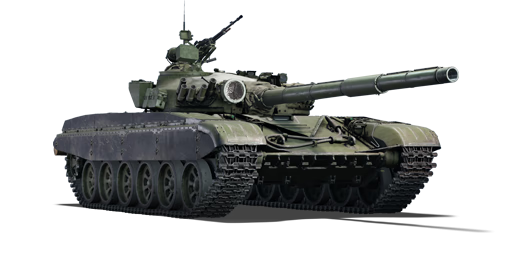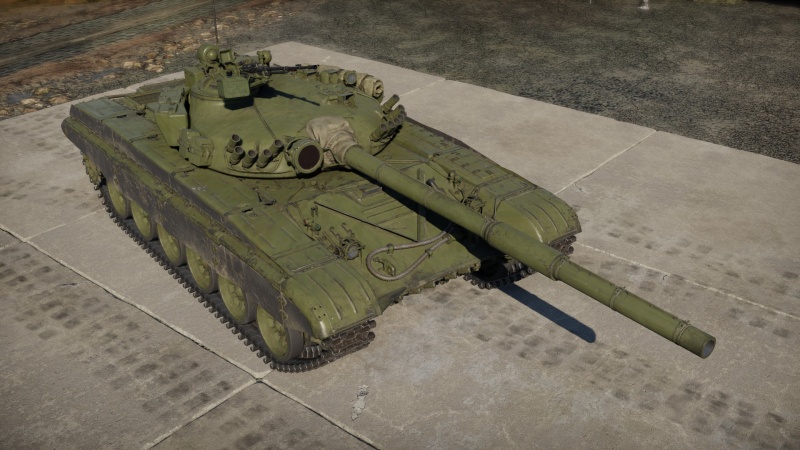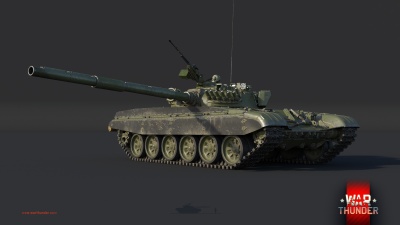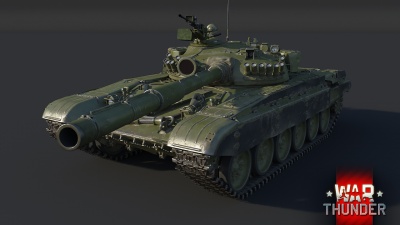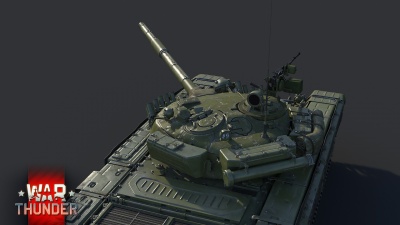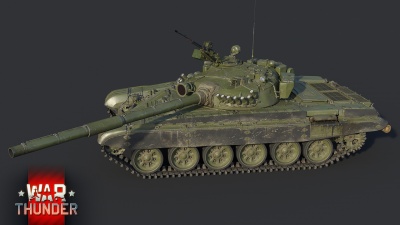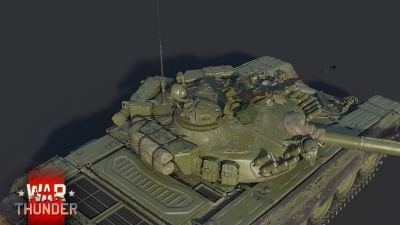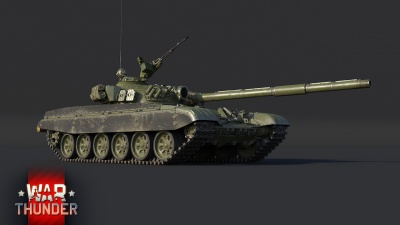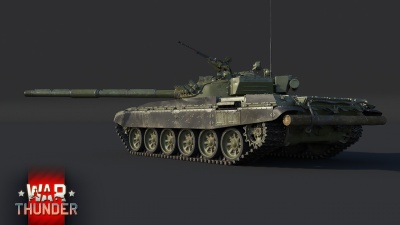Difference between revisions of "T-72A"
CobraKingII (talk | contribs) (→Media) (Tag: Visual edit) |
(Edits) |
||
| Line 10: | Line 10: | ||
== Description == | == Description == | ||
| − | <!--In the description, the first part should be about the history of the creation and combat usage of the vehicle, as well as its key features. In the second part, tell the reader about the ground vehicle in the game. Insert a screenshot of the vehicle, so that if the novice player does not remember the vehicle by name, he will immediately understand what kind of vehicle the article is talking about.--> | + | <!-- ''In the description, the first part should be about the history of the creation and combat usage of the vehicle, as well as its key features. In the second part, tell the reader about the ground vehicle in the game. Insert a screenshot of the vehicle, so that if the novice player does not remember the vehicle by name, he will immediately understand what kind of vehicle the article is talking about.'' --> |
The '''{{Specs|name}}''' is a rank {{Specs|rank}} Soviet medium tank {{Battle-rating}}. It was introduced in [[Update 1.85 "Supersonic"]]. | The '''{{Specs|name}}''' is a rank {{Specs|rank}} Soviet medium tank {{Battle-rating}}. It was introduced in [[Update 1.85 "Supersonic"]]. | ||
| Line 16: | Line 16: | ||
=== Survivability and armour === | === Survivability and armour === | ||
{{Specs-Tank-Armour}} | {{Specs-Tank-Armour}} | ||
| − | <!--Describe armour protection. Note the most well protected and key weak areas. Appreciate the layout of modules as well as the number and location of crew members. Is the level of armour protection sufficient, is the placement of modules helpful for survival in combat? | + | <!-- ''Describe armour protection. Note the most well protected and key weak areas. Appreciate the layout of modules as well as the number and location of crew members. Is the level of armour protection sufficient, is the placement of modules helpful for survival in combat? If necessary use a visual template to indicate the most secure and weak zones of the armour.'' --> |
| − | + | '''Armour type:''' | |
*Cast homogeneous armour (Turret) | *Cast homogeneous armour (Turret) | ||
| Line 29: | Line 29: | ||
|Hull||60 mm (68°) | |Hull||60 mm (68°) | ||
16 mm ''add-on steel plate'' (68°) | 16 mm ''add-on steel plate'' (68°) | ||
| − | |80 mm ''Top'' | + | |80 mm ''Top'' |
20 mm ''Bottom'' | 20 mm ''Bottom'' | ||
|40 mm||30 mm ''frontal roof'' | |40 mm||30 mm ''frontal roof'' | ||
| Line 41: | Line 41: | ||
|- | |- | ||
|} | |} | ||
| − | The T-72A's hull armour is practically the same as the T-64A's; textolite middle sandwiched between two RHA plates. The difference is that the T-72As upper glacis is angled at one degree further back than that of the T-64A and the use of Quartz core instead of Hard Hardness Rolled | + | The T-72A's hull armour is practically the same as the T-64A's; textolite middle sandwiched between two RHA plates. The difference is that the T-72As upper glacis is angled at one degree further back than that of the T-64A and the use of Quartz core instead of Hard Hardness Rolled Armour (HHR) in the turret. Like the T-64 and T-80 line, the T-72A has a carousel-type autoloader centred under the turret. This means that a penetrating hit to the centre of the tank has a high chance of leading to an ammunition detonation and subsequent launch of the turret. This is however slightly less likely to happen with the T-72As type of autoloader, where the charges are stored horizontally (as "=") in comparison to the T-64/-80 type, where the charge sits vertically and is easier to hit. |
Spare ammunition not inside the 22 round carousel is however spread more randomly around the fighting compartment. Therefore, bringing only 23 rounds (for 1 in the gun and 22 in the carousel) limits the chance of the spare ammo detonating in the case of i.e. a turret hit. There are two diesel tank ammo racks within the tank - one to the right of the driver and one between the engine and fighting compartment (with some loose ammo above it). It doesn't take much to realize that like most Soviet MBTs, the T-72A is rather explosive if extra ammo is taken, so great care is needed when showing the hull. The driver should also be aware of having only 3 crew members; if one is knocked out they should be sure to return to an objective point as soon as possible to get a new one. | Spare ammunition not inside the 22 round carousel is however spread more randomly around the fighting compartment. Therefore, bringing only 23 rounds (for 1 in the gun and 22 in the carousel) limits the chance of the spare ammo detonating in the case of i.e. a turret hit. There are two diesel tank ammo racks within the tank - one to the right of the driver and one between the engine and fighting compartment (with some loose ammo above it). It doesn't take much to realize that like most Soviet MBTs, the T-72A is rather explosive if extra ammo is taken, so great care is needed when showing the hull. The driver should also be aware of having only 3 crew members; if one is knocked out they should be sure to return to an objective point as soon as possible to get a new one. | ||
| Line 49: | Line 49: | ||
<!-- ''Write about the mobility of the ground vehicle. Estimate the specific power and manoeuvrability, as well as the maximum speed forwards and backwards.'' --> | <!-- ''Write about the mobility of the ground vehicle. Estimate the specific power and manoeuvrability, as well as the maximum speed forwards and backwards.'' --> | ||
| − | {{tankMobility|abMinHp= 1209|rbMinHp= 690|AoAweight= 0.8}}The T-72A is a slow and sluggish tank which has poor acceleration and handling. It has really poor reverse speed as well as hull traverse. However, it has a powerful engine which makes it capable of pulling and pushing enemy tanks as well as move through rough terrain with ease. It does not have enough horsepower to climb over steep elevations. Speed wise, it has a decent top speed (~60- | + | {{tankMobility|abMinHp= 1209|rbMinHp= 690|AoAweight= 0.8}} |
| + | |||
| + | The T-72A is a slow and sluggish tank which has poor acceleration and handling. It has really poor reverse speed as well as hull traverse. However, it has a powerful engine which makes it capable of pulling and pushing enemy tanks as well as move through rough terrain with ease. It does not have enough horsepower to climb over steep elevations. Speed-wise, it has a decent top speed (~60-70 km/h) which under specific situations it is able to be reached. | ||
=== Modifications and economy === | === Modifications and economy === | ||
| Line 59: | Line 61: | ||
{{Specs-Tank-Weapon|1}} | {{Specs-Tank-Weapon|1}} | ||
<!-- ''Give the reader information about the characteristics of the main gun. Assess its effectiveness in a battle based on the reloading speed, ballistics and the power of shells. Do not forget about the flexibility of the fire, that is how quickly the cannon can be aimed at the target, open fire on it and aim at another enemy. Add a link to the main article on the gun: <code><nowiki>{{main|Name of the weapon}}</nowiki></code>. Describe in general terms the ammunition available for the main gun. Give advice on how to use them and how to fill the ammunition storage.'' --> | <!-- ''Give the reader information about the characteristics of the main gun. Assess its effectiveness in a battle based on the reloading speed, ballistics and the power of shells. Do not forget about the flexibility of the fire, that is how quickly the cannon can be aimed at the target, open fire on it and aim at another enemy. Add a link to the main article on the gun: <code><nowiki>{{main|Name of the weapon}}</nowiki></code>. Describe in general terms the ammunition available for the main gun. Give advice on how to use them and how to fill the ammunition storage.'' --> | ||
| − | {{main|2A46M (125 mm)}}The T-72A has the powerful 2A46M | + | {{main|2A46M (125 mm)}} |
| + | |||
| + | The T-72A has the powerful 2A46M 125 mm smoothbore cannon. It has a powerful selection of rounds, each with different uses and similarities between same types. | ||
{| class="wikitable" style="text-align:center" width="100%" | {| class="wikitable" style="text-align:center" width="100%" | ||
| Line 79: | Line 83: | ||
==== Ammunition ==== | ==== Ammunition ==== | ||
| − | * 3BK12M: this is the starting ammunition which can be seen as poor when in frontal engagements against modern | + | * 3BK12M: this is the starting ammunition which can be seen as poor when in frontal engagements against modern MBTs. However, the decent explosive filler as well as not loosing penetration over distances makes it a decent round for sniping. However, the speed in said round is not fast and will be hard to aim at long distances. It is able to hullbreak light armoured vehicles such as SPAA. |
| − | * 3BM9: this is a tier I steel core APFSDS which has the highest muzzle velocity over all the APFSDS seen. However, the weight as well as penetration make it unreliable when facing top tier | + | * 3BM9: this is a tier I steel core APFSDS which has the highest muzzle velocity over all the APFSDS seen. However, the weight as well as penetration make it unreliable when facing top tier MBTs frontally. |
* 3BM15: this is a tier 2 tungsten core APFSDS which has slightly less muzzle velocity compared to the 3BM9. However, this is the highest pen shot seen in the T-72A with increased weight over the 3BM9. | * 3BM15: this is a tier 2 tungsten core APFSDS which has slightly less muzzle velocity compared to the 3BM9. However, this is the highest pen shot seen in the T-72A with increased weight over the 3BM9. | ||
* 3BM22: this is a tier 4 APFSDS which has same ballistic performance as the 3BM15. However, penetration is reduced for a greater weight. | * 3BM22: this is a tier 4 APFSDS which has same ballistic performance as the 3BM15. However, penetration is reduced for a greater weight. | ||
| Line 132: | Line 136: | ||
==== [[Ammo racks]] ==== | ==== [[Ammo racks]] ==== | ||
[[File:Ammoracks_{{PAGENAME}}.png|right|thumb|x250px|[[Ammo racks]] of the {{PAGENAME}}]] | [[File:Ammoracks_{{PAGENAME}}.png|right|thumb|x250px|[[Ammo racks]] of the {{PAGENAME}}]] | ||
| + | <!-- '''Last updated:''' --> | ||
{| class="wikitable" style="text-align:center" | {| class="wikitable" style="text-align:center" | ||
|- | |- | ||
| Line 141: | Line 146: | ||
! Visual<br>discrepancy | ! Visual<br>discrepancy | ||
|- | |- | ||
| − | | '''44''' || 41 ''(+3)'' || 39 ''(+5)'' || '' | + | | '''44''' || 41 ''(+3)'' || 39 ''(+5)'' || 22 ''(+22)'' || 0 ''(+44)'' || No |
|} | |} | ||
Note: | Note: | ||
| Line 173: | Line 178: | ||
== Usage in battles == | == Usage in battles == | ||
| − | <!--Describe the tactics of playing in the vehicle, the features of using vehicles in the team and advice on tactics. Refrain from creating a "guide" - do not impose a single point of view but instead give the reader food for thought. Describe the most dangerous enemies and give recommendations on fighting them. If necessary, note the specifics of the game in different modes (AB, RB, SB).--> | + | <!-- ''Describe the tactics of playing in the vehicle, the features of using vehicles in the team and advice on tactics. Refrain from creating a "guide" - do not impose a single point of view but instead give the reader food for thought. Describe the most dangerous enemies and give recommendations on fighting them. If necessary, note the specifics of the game in different modes (AB, RB, SB).'' --> |
| − | |||
| − | |||
| − | ' | + | The T-72A play-style is near identical to the [[T-64A (1971)|T-64A]] (and also subsequent Soviet MBTs). One of the key differences between the two vehicles is the T-72A's stronger armour. The quartz core composed turret will also bounce many shots and can even eat up some of the strongest ATGMs. In terms of armament, the T-72A boasts the very powerful and accurate [[2A46M (125 mm)|2A46M]] that Soviet high-rank tankers will quickly become familiar and fall in love with. Make sure to research the 3BM15 sabot rounds as soon as you can (after Parts and FPE of course), as the stock round has mediocre penetration for a sabot. |
| − | * [[XM-1 (Chrysler) | + | '''Enemies worth noting:''' |
| − | + | * [[XM-1 (Chrysler)]]/[[XM-1 (GM)|(GM)]]: Avoid attempting combat with the 3BK18M HEATFS shells, despite their having thin composite armour | |
| − | * [[AMX-30B2]]/[[AMX-30B2 BRENUS]]: | + | * [[AMX-30B2]]/[[AMX-30B2 BRENUS]]: DM23/33 have enough armour penetration to penetrate T-72 driver frontal plates, though all shells are effective against them in return. |
| − | * [[Leopard 2K]]: | + | * [[Leopard 2K]]: Turret mantlet is resistant to 3BK18M. |
| − | + | * [[AMX-40]]: Turret mantlet and lower frontal plate are highly resistant to 3BK18M. | |
| − | * [[AMX-40]]: | + | * [[Strv 103 (Family)|Strv 103]]: Depending on the hull angling, HEAT-FS rounds such as the 3BK18M might ricochet. APFSDS is recommended to be used when facing it frontally. |
| − | * [[Strv 103 (Family)|Strv 103]]: | ||
=== Pros and cons === | === Pros and cons === | ||
| − | <!--Summarise and briefly evaluate the vehicle in terms of its characteristics and combat effectiveness. Mark its pros and cons in a bulleted list. Try not to use more than 6 points for each of the characteristics. Avoid using categorical definitions such as "bad", "good" and the like - use substitutions with softer forms such as "inadequate" and "effective".--> | + | <!-- ''Summarise and briefly evaluate the vehicle in terms of its characteristics and combat effectiveness. Mark its pros and cons in a bulleted list. Try not to use more than 6 points for each of the characteristics. Avoid using categorical definitions such as "bad", "good" and the like - use substitutions with softer forms such as "inadequate" and "effective".'' --> |
'''Pros:''' | '''Pros:''' | ||
| Line 214: | Line 216: | ||
== History == | == History == | ||
| − | <!--Describe the history of the creation and combat usage of the | + | <!-- ''Describe the history of the creation and combat usage of the vehicle in more detail than in the introduction. If the historical reference turns out to be too long, take it to a separate article, taking a link to the article about the vehicle and adding a block "/History" (example: <nowiki>https://wiki.warthunder.com/(Vehicle-name)/History</nowiki>) and add a link to it here using the <code>main</code> template. Be sure to reference text and sources by using <code><nowiki><ref></ref></nowiki></code>, as well as adding them at the end of the article with <code><nowiki><references /></nowiki></code>. This section may also include the vehicle's dev blog entry (if applicable) and the in-game encyclopedia description (under <code><nowiki>=== In-game description ===</nowiki></code>, also if applicable).'' --> |
Development of the T-72 began shortly after the production of the T-64 highlighted several problems which negatively impacted production rates. Among these problems was an unreliable engine, which couldn't be produced at the high rates needed for a smooth production of the T-64 to take place. | Development of the T-72 began shortly after the production of the T-64 highlighted several problems which negatively impacted production rates. Among these problems was an unreliable engine, which couldn't be produced at the high rates needed for a smooth production of the T-64 to take place. | ||
| − | In response, the Uralvagonzavod plant began working on a modified version of the T-64, which would use a more reliable and readily available engine, in order to provide the army with a tank fit for mass-production. Apart from this, changes were also made to the | + | In response, the Uralvagonzavod plant began working on a modified version of the T-64, which would use a more reliable and readily available engine, in order to provide the army with a tank fit for mass-production. Apart from this, changes were also made to the armour layout, in order to simplify production and decrease costs. This work resulted in the creation of the Object 172. |
Development of the Object 172 continued, and after some trials, the vehicle entered service with the Soviet Army in August 1973, receiving its official designation T-72. Shortly afterwards, the vehicle was permitted for mass production, following the issuing of an official decree in 1974. | Development of the Object 172 continued, and after some trials, the vehicle entered service with the Soviet Army in August 1973, receiving its official designation T-72. Shortly afterwards, the vehicle was permitted for mass production, following the issuing of an official decree in 1974. | ||
| Line 226: | Line 228: | ||
Since production began in 1974, over 20,000 T-72 tanks were built across several modifications in the Soviet Union/Russia alone, with production of more modern variants still ongoing today, even in other countries as well. | Since production began in 1974, over 20,000 T-72 tanks were built across several modifications in the Soviet Union/Russia alone, with production of more modern variants still ongoing today, even in other countries as well. | ||
| − | ''- From [ | + | ''- From [[wt:en/news/5945-development-t-72a-the-globetrotter-en|Devblog]]'' |
| − | The T-72 series tank was developed as a direct prototype of the T-64 mechanical issues correction. In 1962, while working on the corrections of production problems, specially engine and firepower, a new prototype was developed with the 2A46M 125mm smoothbore gun and the V-45K diesel engine. This prototype was renamed to Object 172. While being in an unclear political process, decree number 326-113 was issued, freeing | + | The T-72 series tank was developed as a direct prototype of the T-64 mechanical issues correction. In 1962, while working on the corrections of production problems, specially engine and firepower, a new prototype was developed with the 2A46M 125mm smoothbore gun and the V-45K diesel engine. This prototype was renamed to Object 172. While being in an unclear political process, decree number 326-113 was issued, freeing Uralvagonzavod from the production of the T-64A. The first batch was produced and set under the name of "Object 172M". It was tested again in 1972 and accepted to service under the name of T-72. License production was sold to multiple countries as well as unit batches to Warsaw pact nations and exported to other countries such as India, Syria, Finland, Iraq and Yugoslavia. After the collapse of the USSR in 1991, some of the independent countries kept the tanks such as Ukraine. |
== Media == | == Media == | ||
| Line 237: | Line 239: | ||
* [https://live.warthunder.com/feed/camouflages/?vehicleCountry=ussr&vehicleType=tank&vehicleClass=medium_tank&vehicle=ussr_t_72a Skins and camouflages for the {{PAGENAME}} from live.warthunder.com.] | * [https://live.warthunder.com/feed/camouflages/?vehicleCountry=ussr&vehicleType=tank&vehicleClass=medium_tank&vehicle=ussr_t_72a Skins and camouflages for the {{PAGENAME}} from live.warthunder.com.] | ||
| − | '''Images'''<gallery mode="packed" heights="150"> | + | '''Images''' |
| + | <gallery mode="packed" heights="150"> | ||
File:T-72A WTWallpaper 01.jpg| | File:T-72A WTWallpaper 01.jpg| | ||
File:T-72A WTWallpaper 02.jpg| | File:T-72A WTWallpaper 02.jpg| | ||
| Line 265: | Line 268: | ||
== External links == | == External links == | ||
| − | <!--''Paste links to sources and external resources, such as:'' | + | <!-- ''Paste links to sources and external resources, such as:'' |
* ''topic on the official game forum;'' | * ''topic on the official game forum;'' | ||
| − | * ''other literature.''--> | + | * ''other literature.'' --> |
* [[wt:en/news/5945-development-t-72a-the-globetrotter-en|[Devblog] T-72A: The Globetrotter]] | * [[wt:en/news/5945-development-t-72a-the-globetrotter-en|[Devblog] T-72A: The Globetrotter]] | ||
Revision as of 17:43, 15 February 2021
| This page is about the Soviet medium tank T-72A. For other versions, see T-72 (Family). |
Contents
Description
The T-72A is a rank VI Soviet medium tank with a battle rating of 9.3 (AB/RB/SB). It was introduced in Update 1.85 "Supersonic".
General info
Survivability and armour
Armour type:
- Cast homogeneous armour (Turret)
- Rolled homogeneous armour (Hull)
| Armour | Front (Slope angle) | Sides | Rear | Roof |
|---|---|---|---|---|
| Hull | 60 mm (68°)
16 mm add-on steel plate (68°) |
80 mm Top
20 mm Bottom |
40 mm | 30 mm frontal roof
20 mm engine deck roof |
| Turret | 280 - 200 mm Turret front (variable angles)
150 - 400 mm Gun mantlet (variable angles) |
240 - 130 mm | 75 mm | 45 mm |
| Cupola | 100 mm (variable angles) | 100 mm (varible angles) | 100 mm (variable angles) | 45 mm |
The T-72A's hull armour is practically the same as the T-64A's; textolite middle sandwiched between two RHA plates. The difference is that the T-72As upper glacis is angled at one degree further back than that of the T-64A and the use of Quartz core instead of Hard Hardness Rolled Armour (HHR) in the turret. Like the T-64 and T-80 line, the T-72A has a carousel-type autoloader centred under the turret. This means that a penetrating hit to the centre of the tank has a high chance of leading to an ammunition detonation and subsequent launch of the turret. This is however slightly less likely to happen with the T-72As type of autoloader, where the charges are stored horizontally (as "=") in comparison to the T-64/-80 type, where the charge sits vertically and is easier to hit.
Spare ammunition not inside the 22 round carousel is however spread more randomly around the fighting compartment. Therefore, bringing only 23 rounds (for 1 in the gun and 22 in the carousel) limits the chance of the spare ammo detonating in the case of i.e. a turret hit. There are two diesel tank ammo racks within the tank - one to the right of the driver and one between the engine and fighting compartment (with some loose ammo above it). It doesn't take much to realize that like most Soviet MBTs, the T-72A is rather explosive if extra ammo is taken, so great care is needed when showing the hull. The driver should also be aware of having only 3 crew members; if one is knocked out they should be sure to return to an objective point as soon as possible to get a new one.
Mobility
| Game Mode | Max Speed (km/h) | Weight (tons) | Engine power (horsepower) | Power-to-weight ratio (hp/ton) | ||||
|---|---|---|---|---|---|---|---|---|
| Forward | Reverse | Stock | AoA | Stock | Upgraded | Stock | Upgraded | |
| Arcade | 67 | 5 | 40.2 | 0.8 | 1209 | 1,488 | 30.07 | 36.29 |
| Realistic | 60 | 5 | 690 | 780 | 17.16 | 19.02 | ||
The T-72A is a slow and sluggish tank which has poor acceleration and handling. It has really poor reverse speed as well as hull traverse. However, it has a powerful engine which makes it capable of pulling and pushing enemy tanks as well as move through rough terrain with ease. It does not have enough horsepower to climb over steep elevations. Speed-wise, it has a decent top speed (~60-70 km/h) which under specific situations it is able to be reached.
Modifications and economy
Armaments
Main armament
The T-72A has the powerful 2A46M 125 mm smoothbore cannon. It has a powerful selection of rounds, each with different uses and similarities between same types.
| 125 mm 2A46M | Turret rotation speed (°/s) | Reloading rate (seconds) | |||||||||||
|---|---|---|---|---|---|---|---|---|---|---|---|---|---|
| Mode | Capacity | Vertical | Horizontal | Stabilizer | Stock | Upgraded | Full | Expert | Aced | Stock | Full | Expert | Aced |
| Arcade | 44 | -6°/+13° | ±180° | Two-plane | 19.0 | 26.3 | 32.0 | 35.4 | 37.6 | 7.10 | 7.10 | 7.10 | 7.10 |
| Realistic | 11.9 | 14.0 | 17.0 | 18.8 | 20.0 | ||||||||
Ammunition
- 3BK12M: this is the starting ammunition which can be seen as poor when in frontal engagements against modern MBTs. However, the decent explosive filler as well as not loosing penetration over distances makes it a decent round for sniping. However, the speed in said round is not fast and will be hard to aim at long distances. It is able to hullbreak light armoured vehicles such as SPAA.
- 3BM9: this is a tier I steel core APFSDS which has the highest muzzle velocity over all the APFSDS seen. However, the weight as well as penetration make it unreliable when facing top tier MBTs frontally.
- 3BM15: this is a tier 2 tungsten core APFSDS which has slightly less muzzle velocity compared to the 3BM9. However, this is the highest pen shot seen in the T-72A with increased weight over the 3BM9.
- 3BM22: this is a tier 4 APFSDS which has same ballistic performance as the 3BM15. However, penetration is reduced for a greater weight.
| Penetration statistics | |||||||
|---|---|---|---|---|---|---|---|
| Ammunition | Type of warhead |
Penetration @ 0° Angle of Attack (mm) | |||||
| 10 m | 100 m | 500 m | 1,000 m | 1,500 m | 2,000 m | ||
| 3BK12M | HEATFS | 440 | 440 | 440 | 440 | 440 | 440 |
| 3OF26 | HE | 42 | 42 | 42 | 42 | 42 | 42 |
| 3BM9 | APFSDS | 321 | 317 | 303 | 285 | 268 | 249 |
| 3BM15 | APFSDS | 440 | 430 | 420 | 410 | 405 | 400 |
| 3BM22 | APFSDS | 425 | 420 | 415 | 405 | 393 | 380 |
| Shell details | |||||||||
|---|---|---|---|---|---|---|---|---|---|
| Ammunition | Type of warhead |
Velocity (m/s) |
Projectile Mass (kg) |
Fuse delay (m) |
Fuse sensitivity (mm) |
Explosive Mass (TNT equivalent) (g) |
Ricochet | ||
| 0% | 50% | 100% | |||||||
| 3BK12M | HEATFS | 905 | 19 | 0.05 | 0.1 | 2,530 | 65° | 72° | 77° |
| 3OF26 | HE | 850 | 23 | 0 | 0.1 | 5,240 | 79° | 80° | 81° |
| 3BM9 | APFSDS | 1,800 | 3.6 | N/A | N/A | N/A | 72° | 76° | 78° |
| 3BM15 | APFSDS | 1,780 | 3.88 | N/A | N/A | N/A | 76° | 77° | 80° |
| 3BM22 | APFSDS | 1,760 | 4.83 | N/A | N/A | N/A | 76° | 77° | 80° |
Ammo racks
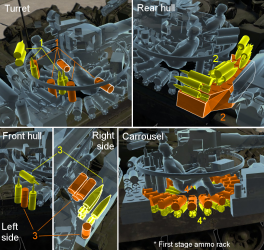
| Full ammo |
1st rack empty |
2nd rack empty |
3rd rack empty |
4th rack empty |
Visual discrepancy |
|---|---|---|---|---|---|
| 44 | 41 (+3) | 39 (+5) | 22 (+22) | 0 (+44) | No |
Note:
- The T-72A uses two-piece ammunition, composed of propellant bags (orange) and projectiles (yellow). Both have separate racks.
Machine guns
| 12.7 mm NSVT | ||||
|---|---|---|---|---|
| Mount | Capacity (Belt) | Fire rate | Vertical | Horizontal |
| Pintle | 300 (150) | 700 | -4°/+75° | ±180° |
| 7.62 mm PKT | ||||
|---|---|---|---|---|
| Mount | Capacity (Belt) | Fire rate | Vertical | Horizontal |
| Coaxial | 2,000 (250) | 700 | N/A | N/A |
Usage in battles
The T-72A play-style is near identical to the T-64A (and also subsequent Soviet MBTs). One of the key differences between the two vehicles is the T-72A's stronger armour. The quartz core composed turret will also bounce many shots and can even eat up some of the strongest ATGMs. In terms of armament, the T-72A boasts the very powerful and accurate 2A46M that Soviet high-rank tankers will quickly become familiar and fall in love with. Make sure to research the 3BM15 sabot rounds as soon as you can (after Parts and FPE of course), as the stock round has mediocre penetration for a sabot.
Enemies worth noting:
- XM-1 (Chrysler)/(GM): Avoid attempting combat with the 3BK18M HEATFS shells, despite their having thin composite armour
- AMX-30B2/AMX-30B2 BRENUS: DM23/33 have enough armour penetration to penetrate T-72 driver frontal plates, though all shells are effective against them in return.
- Leopard 2K: Turret mantlet is resistant to 3BK18M.
- AMX-40: Turret mantlet and lower frontal plate are highly resistant to 3BK18M.
- Strv 103: Depending on the hull angling, HEAT-FS rounds such as the 3BK18M might ricochet. APFSDS is recommended to be used when facing it frontally.
Pros and cons
Pros:
- Mounts the same powerful 125 mm 2A46 gun as on the T-64 and T-80 (though an earlier version)
- Low profile, small target compared to other countries' main battle tanks
- Early unlocked laser rangefinder makes sniping long distances easier
- Has both smoke grenade launchers and ESS
- Due to thick frontal armour and correct angling, able to deflect most rounds from counterpart tanks of other countries
- Very accurate gun due to the high muzzle velocity of the APFSDS rounds, very effective long-range sniper
- Autoloader continues working even if fighting a fire or replacing a crew member, ready to use upon the fire being extinguished or the gunner having been replaced
Cons:
- Ammo carousel means your first stage rounds all are centred below the turret; can be easily detonated through a hit to the hull
- Very slow reverse speed and traverse speed, a problem in situations where you cannot back away from an attacking enemy
- 3-man crew makes tank able to be knocked out easier; once one crewmember is knocked out, you have to be very careful not to get hit again
- Gun depression inadequate for most hull-down situations, e.g. sniping from a hill or down a valley
- Driver's port is still a weakness
- Poor top speed
- Inferior optics with only one 8x zoom level
- 1st APFSDS modification is inferior to most contemporary rounds and 3BM22 is a Rank IV modification
- Its 2A46 125 mm gun is an early type; the stock ammunition is lacklustre and it cannot fire ATGMs like the T-64B, T-80B, and T-80U
- Glacis armour is not reliable until the addon armour plate is unlocked (a tier IV modification)
History
Development of the T-72 began shortly after the production of the T-64 highlighted several problems which negatively impacted production rates. Among these problems was an unreliable engine, which couldn't be produced at the high rates needed for a smooth production of the T-64 to take place.
In response, the Uralvagonzavod plant began working on a modified version of the T-64, which would use a more reliable and readily available engine, in order to provide the army with a tank fit for mass-production. Apart from this, changes were also made to the armour layout, in order to simplify production and decrease costs. This work resulted in the creation of the Object 172.
Development of the Object 172 continued, and after some trials, the vehicle entered service with the Soviet Army in August 1973, receiving its official designation T-72. Shortly afterwards, the vehicle was permitted for mass production, following the issuing of an official decree in 1974.
The T-72 was also heavily exported to and produced by nations of the Warsaw Pact as well as other countries worldwide, although these vehicles received certain downgrades compared to native Soviet models. Despite this, the T-72 quickly became one of the most widely used tanks in the world, participating in more conflicts than a single devblog could ever cover.
Since production began in 1974, over 20,000 T-72 tanks were built across several modifications in the Soviet Union/Russia alone, with production of more modern variants still ongoing today, even in other countries as well.
- From Devblog
The T-72 series tank was developed as a direct prototype of the T-64 mechanical issues correction. In 1962, while working on the corrections of production problems, specially engine and firepower, a new prototype was developed with the 2A46M 125mm smoothbore gun and the V-45K diesel engine. This prototype was renamed to Object 172. While being in an unclear political process, decree number 326-113 was issued, freeing Uralvagonzavod from the production of the T-64A. The first batch was produced and set under the name of "Object 172M". It was tested again in 1972 and accepted to service under the name of T-72. License production was sold to multiple countries as well as unit batches to Warsaw pact nations and exported to other countries such as India, Syria, Finland, Iraq and Yugoslavia. After the collapse of the USSR in 1991, some of the independent countries kept the tanks such as Ukraine.
Media
- Skins
Images
- Videos
See also
- Vehicles equipped with the same chassis
- Other vehicles of similar configuration and role
External links
| USSR medium tanks | |
|---|---|
| T-28 | T-28 (1938) · T-28 · T-28E |
| T-34-76 | T-34 (Prototype) · T-34 (1940) · T-34 (1941) · T-34 (1st Gv.T.Br.) · T-34 (1942) · T-34E STZ · T-34E |
| T-34-57 | T-34-57 · T-34-57 (1943) |
| T-34-85 | T-34-85 (D-5T) · T-34-85 · T-34-85E |
| T-34-100 | T-34-100 |
| T-44 | T-44 · T-44-100 · T-44-122 |
| T-54 | T-54 (1947) · T-54 (1949) · T-54 (1951) |
| T-55 | TO-55 · T-55A · T-55AM-1 · T-55AMD-1 |
| T-62 | T-62 · T-62M-1 |
| T-64 | Object 435 · T-64A (1971) · T-64B |
| T-72 | T-72A · T-72AV (TURMS-T) · T-72B · T-72B (1989) · T-72B3 · T-72M2 Moderna |
| T-80 | T-80B · T-80U · T-80UD · T-80UK · T-80UM2 · Т-80U-Е1 · T-80BVM · Object 292 |
| T-90 | Т-90А · T-90M |
| Trophies/Lend-Lease | |
| Germany | ▂T-III · ▂T-V |
| Great Britain | ▂МК-IX "Valentine" |
| USA | ▂M3 Medium · ▂M4A2 |


